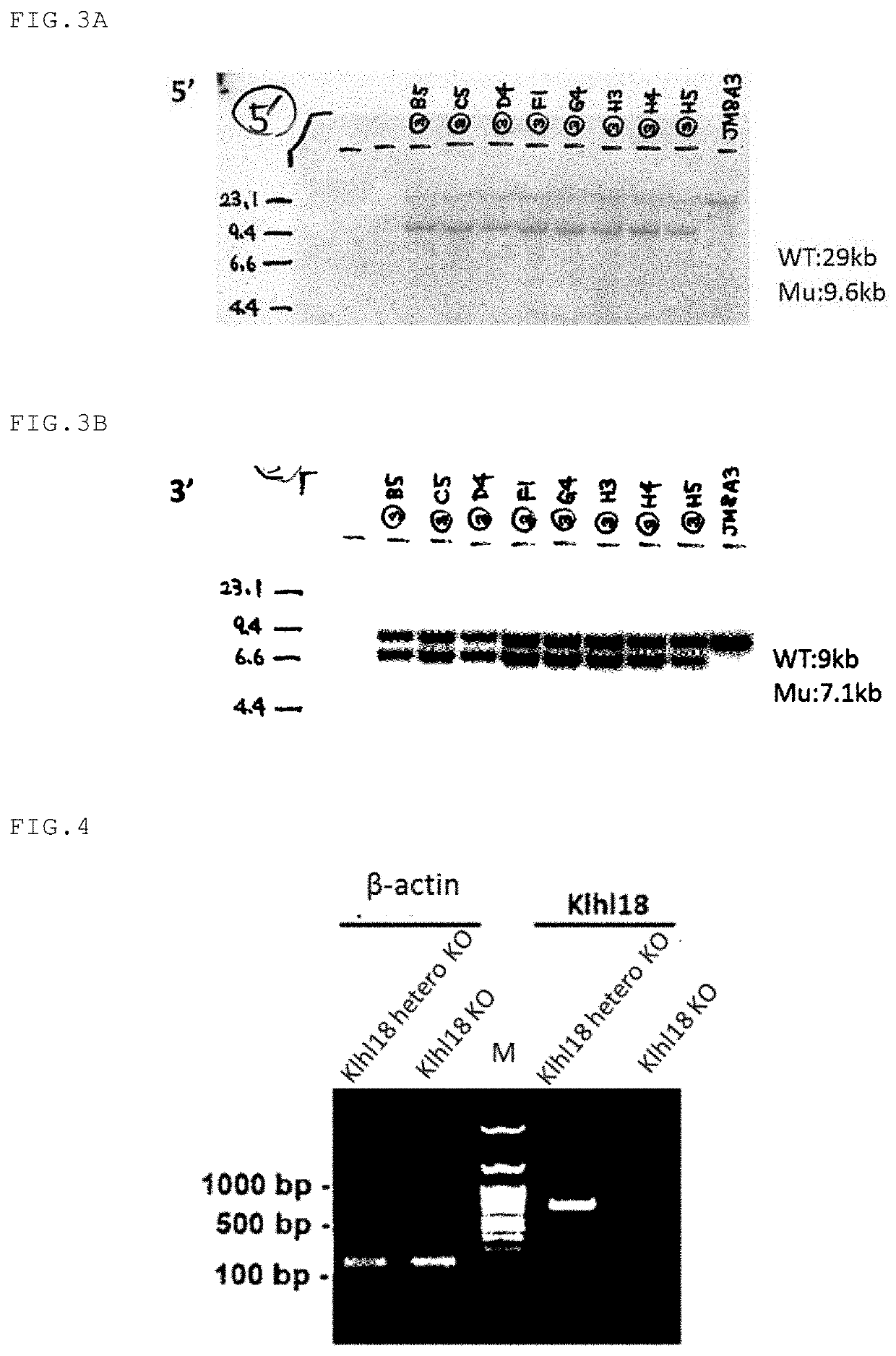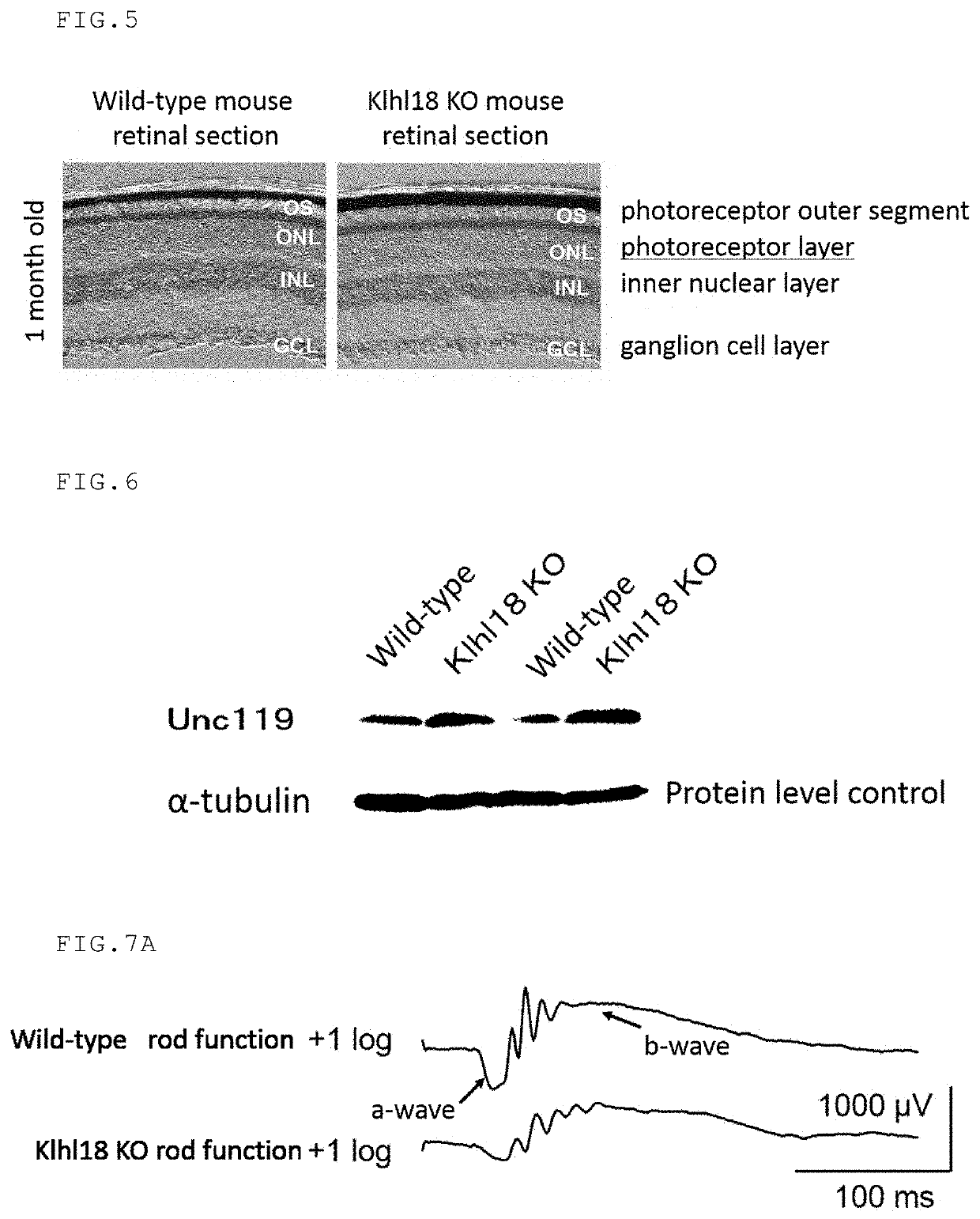Agent for inhibiting or reducing light sensitivity
a technology of light sensitivity and light sensitivity inhibition, which is applied in the direction of enzyme inhibitor ingredients, instruments, peptide/protein ingredients, etc., can solve the problems of shortening the healthy life expectancy of the visually impaired, imposing a heavy burden on caregivers, and deteriorating the quality of life, so as to enhance or maintain light sensitivity, inhibit or reduce light sensitivity
- Summary
- Abstract
- Description
- Claims
- Application Information
AI Technical Summary
Benefits of technology
Problems solved by technology
Method used
Image
Examples
example 1
Expression Analysis of Klhl18 Gene in Mouse Tissue
Northern Blotting
(1) Preparation of Probe for Northern Blot Analysis
[0176]RNA was extracted from the retina of ICR mice of postnatal 14 days (purchased from Oriental Yeast Co., Ltd.) using Trizol reagent (Thermo Fisher Scientific) according to the attached protocol, and then a cDNA library was prepared according to the conventional method. PCR was performed with Ex Taq (Takara) using the cDNA library as a template according to the attached protocol to amplify the Klhl18 gene. The primers used for the PCR were a forward primer (SEQ ID NO: 58) and a reverse primer (SEQ ID NO: 59). The amplified PCR fragment was integrated into the pGEM-T-easy plasmid (Promega) using Ligation High Ver. 2 (TOYOBO) according to the attached protocol to give the pGEM-T-easy-Klhl18 plasmid.
[0177]A Klhl18 DNA fragment was excised from the pGEM-T-easy-Klhl18 plasmid with the restriction enzyme EcoRI. The Klhl18 DNA fragment was radioactively labeled with 32P ...
example 2
Expression Analysis of Klhl18 Gene in Mouse Retina In Situ Hybridization
(1) Preparation of Probe for In Situ Hybridization Analysis
[0180]The pGEM-T-easy-Klhl18 plasmid prepared in Example 1 was treated with the restriction enzyme ApaI according to the conventional method to linearize the plasmid. A digoxigenin (DIG)-labeled antisense RNA strand was synthesized using the linearized DNA as a template with SP6 RNA Polymerase (GE Healthcare) according to the attached protocol. After completion of the synthesis of the antisense RNA strand, the linear DNA used as a template was degraded with RNase free DNase (GE Healthcare). The antisense RNA strand was purified by ethanol precipitation, dissolved in 50 μL of sterile water, and stored at −80° C.
(2) Hybridization
[0181]The retina of ICR mice of postnatal 9 days and 21 days (purchased from Oriental Yeast Co., Ltd.) were harvested according to the conventional method, and fixed in 4% paraformaldehyde / PBS (Phosphate Buffer Saline) at 4° C. ove...
example 3
Preparation of Klhl18 Gene-Deficient Mice
[0185](1) Establishment of ES Cell Line that are Heterozygous for Klhl18 Gene by Homologous Recombination
[0186]The ES cell line JM8A3 from mice of C57BL / 6N background was used as ES cells. ES cells were cultured in DMEM medium (Sigma) supplemented with inactivated fetal bovine serum (FBS), L-glutamine (GIBCO), MEM Non-Essential Amino Acids Solution (GIBCO), Na-pyruvate (GIBCO), penicillin (100 μg / mL) / streptomycin (100 μg / mL) (Nacalai Tesque), 2-mercaptoethanol (Nacalai Tesque), and LIF (CHEMICON). Mouse primary embryonic fibroblast cells having a neomycin-resistant transgene were treated with mitomycin C to arrest cell division and used as feeder cells. The Klhl18 KO vector (Clone name: PRPGS00036_C_D09) was purchased from KOMP
[0187](Knockout Mouse Project, USA). The Klhl18 KO vector was linearized by cleaving it with AsiSI (New England Biolabs), and the linearized DNA fragment was electroporated into the mouse ES cells at 240 V and 500 μF to...
PUM
| Property | Measurement | Unit |
|---|---|---|
| Sensitivity | aaaaa | aaaaa |
Abstract
Description
Claims
Application Information
 Login to View More
Login to View More - R&D
- Intellectual Property
- Life Sciences
- Materials
- Tech Scout
- Unparalleled Data Quality
- Higher Quality Content
- 60% Fewer Hallucinations
Browse by: Latest US Patents, China's latest patents, Technical Efficacy Thesaurus, Application Domain, Technology Topic, Popular Technical Reports.
© 2025 PatSnap. All rights reserved.Legal|Privacy policy|Modern Slavery Act Transparency Statement|Sitemap|About US| Contact US: help@patsnap.com



